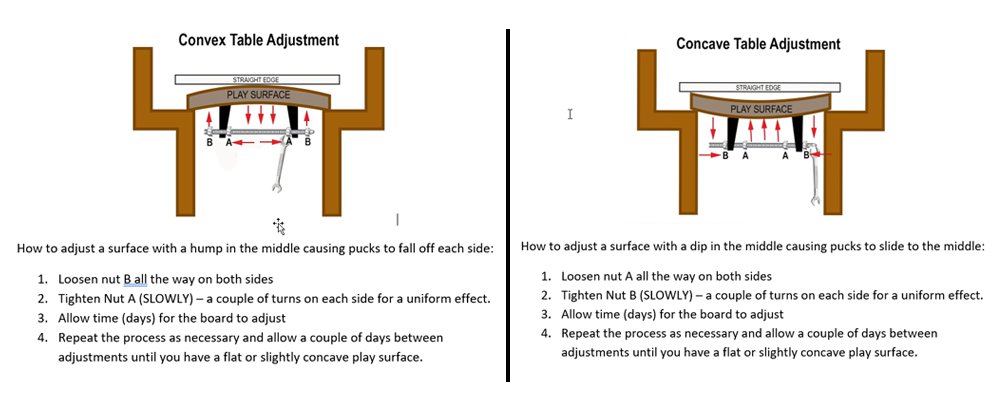
Start by leveling the cabinet or better yet the board inside the cabinet. A 24″ carpenter’s level will work well for this purpose. You will need to get the board level along its width and length.
First, find the low spots and place small shims (2″ x 2″ square pieces of thin wood) under the low legs until the board is level from side to side and from end to end. Ideally, you want the length of the board to be level in the center while slightly uphill on each end. This will allow for easier hangers (when the puck comes to rest partially hanging off the board). Hangers give you the highest score in many shuffleboard games. Once the board is level along the width and length you will place a shim under each of the end legs. After a day or two the center of the board will slowly settle down and the slight uphill bias at the ends will be achieved.
You can now sprinkle some shuffleboard wax on the surface and toss a puck down each side to see how it plays. The last 30″ of the board in each end is the most critical areas as it is here where the pucks come to their final resting spot. It is fine if the board is perfectly flat at each end. However, if it is convex, the pucks will tend to fall off each side and this is completely unacceptable. If the board is too concave the pucks will quickly settle into the middle. Ideally, the board should have a slight concavity that ever so slightly pulls the pucks toward the center as it comes to rest.
The curvature of the board is achieved by adjusting the climatic adjusters which are located underneath the board. A typical shuffleboard has between 4 and 8 climatic adjusters depending upon it’s overall length. Think of the climatic adjusters as you would braces on your teeth. Tightening one way will pull the center of the board down and tightening in the opposite direction will push the center of the board up creating the desired curvature. Remember, you want the board to be slightly concave at each end or dead flat.
You can use a straight edge (an 18″ or 24″ metal level) to check the curvature. On each end of the board, above the climatic adjuster, place the straight edge along the 20″wide board. You will see right away if the board is flat, convex or concave. If it is high in the middle the straight edge will rock and if it is low in the middle you will see daylight. Ideally you want to be able to slip one playing card through the center of the board as this will give you the proper concavity at each end of the board.
For a concave table, if the dip in the middle is too severe, the distance between the climatic adjusters needs to be decreased, making the table more level. Loosen the two bolts in between the climatic adjusters, then very slowly (a couple turns for each nut) turn the outer two bolts in a clockwise motion. After a couple of days, check the board and repeat the adjustment if necessary.
For a convex table, the process is similar but the instructions are opposite. Loosen the two bolts on the outside of the adjusters, then slowly tighten the inner bolts, pushing the climate adjusters farther apart. As with concave, make sure to adjust very slowly (only a couple turns per bolt) and test the board after a couple days and repeat if necessary
See diagram below…
Convex Table Adjustment (Hump)
Instructions how to adjust a surface that has a hump in the middle causing pucks to fall off each side:
- Loosen nut B all the way on both sides
- Tighten Nut A (SLOWLY) – a couple of turns on each side for a uniform effect.
- Allow time (days) for the board to adjust
- Repeat the process as necessary and allow a couple of days between adjustments until you have a flat or slightly concave play surface.
Concave Table Adjustment (Dip)
Instructions how to adjust a surface that has a dip in the middle causing pucks to slide to the middle:
- Loosen nut A all the way on both sides
- Tighten Nut B (SLOWLY) – a couple of turns on each side for a uniform effect.
- Allow time (days) for the board to adjust
- Repeat the process as necessary and allow a couple of days between adjustments until you have a flat or slightly concave play surface.
